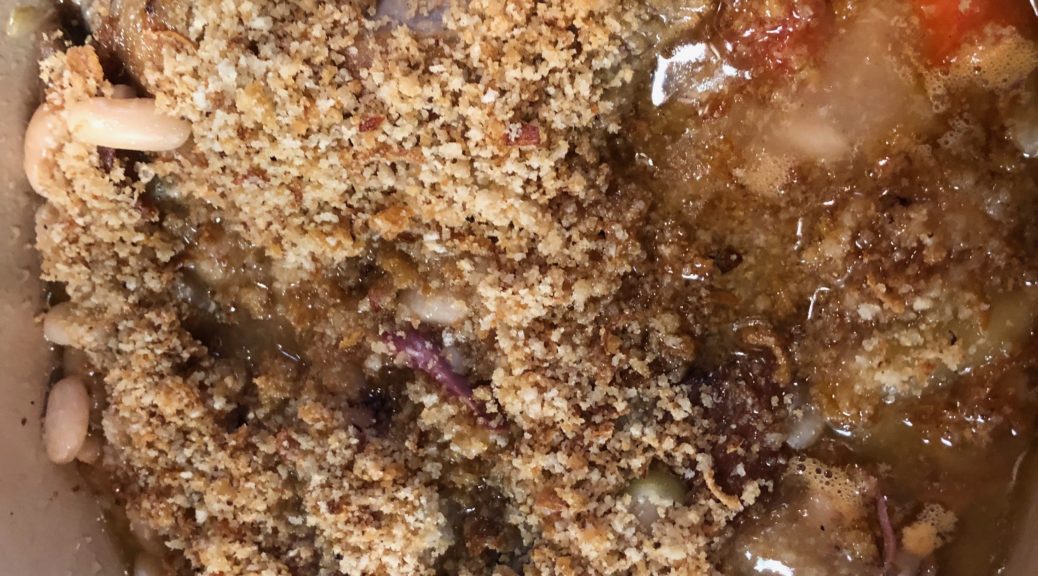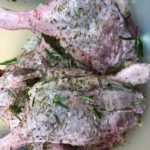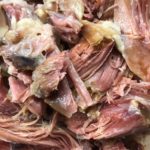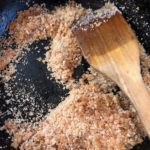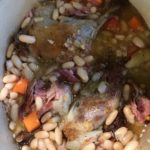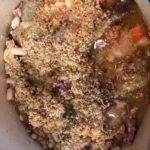My girlfriend doesn’t eat pork. No, she is not Jewish or Moslem, nor, in the words of Samuel L Jackson in Pulp Fiction, does she “dig no swine”. Pork causes a bad reaction in her, maybe an allergy. This is a great shame, though thankfully the same is not true of bacon or sausages, presumably because of the curing and/or processing associated with those products. I’ll return to this point in a moment.
Recently we drove halfway across Europe to Heidelberg to visit my son and take him a carful of his stuff, all the better to equip him for his year at the university there. On the way back we had intended to stop in Lille for dinner at a well-reviewed bistro called Chez Max. Alas, time and traffic got in the way so we worked our way through rush hour, arriving at Calais with just enough time to tear around Carrefour and buy as much wine, charcuterie, cheese, bread and olives as we could carry, before making it to Le Shuttle terminal and enjoying a makeshift picnic under La Manche.
To compensate, I promised to do her a French evening. You know, French food and wine, French music, a French movie, all part of the Entente Cordiale pre-Brexit. The menu would consist of hearty cuisine bourgeoise, the backbone of French classics, so obviously Cassoulet followed by Crêpes Suzettes would fit the mark.
However, my first attempt at cassoulet (see here) would not fit the bill for two reasons: I didn’t make the confit duck; and the recipe includes belly pork, as indeed have French cassoulet recipes since time began. In fairness, the dish might also include mutton and whatever other meats fell to hand, so I felt no qualms about making a cassoulet with a bacon hock, lardons and Toulouse sausage, along with proper homemade confit duck.
Confit duck
It is with the latter that I will begin, which is a dish you can make any time and store in its own fat for months on end. Whether you use it in cassoulet or crisp it up for a solo performance is up to you, but this is a great way to use tasty legs, sorry duck legs joints with thighs, while you roast your breasts, sorry your duck breasts.
I bought a pack of meaty legs from Wick Farm in Colchester, who thoughtfully delivered. Providing they are defrosted, wash them off and dry the legs with care.
Then put them in a large bowl for curing along with the following ingredients. The purpose of this salting stage is to remove water from the duck, so remember to turn them over every few hours, adding more salt as required, and pour off the water as you do.
Ingredients
- 6 cumin seeds
- 12 coriander seeds
- 3 juniper berries
- 50g flaky sea salt (Maldon smoked is best)
- 6 duck leg and thigh joints
- 1 small bunch thyme
- 1 rosemary branch
- 1 unpeeled garlic clove, sliced, plus 1 whole garlic bulb, halved
- c500g goose or duckfat, enough to totally submerge the duck legs
- 2 bay leaves
- 1 tsp black peppercorns
Method
The point about cooking confit duck is that it is the polar opposite of deep fried. What you are doing is salting, slow-cooking then storing the cured duck in duck fat, an action which might cause modern audiences to go slack-jawed in horror, but which is a classic form of preservation.
You don’t need to employ the fat thereafter, though frying the duck in duck fat yields wonderful results, and the fat is of course the perfect way to roast spuds for your Sunday dinner. If that is not your thing, can I urge you to give the fat to someone who will appreciate it!
- The day before cooking, put the cumin and coriander seeds in a dry pan and toast until they are slightly coloured and aromatic. Remove to a board and crush them with the blade of a knife. Crush the juniper berries and mix with the spices and the salt.
- Rub the mixture over the duck, scatter with thyme, rosemary and sliced garlic and chill for 24 hrs, turning two or three times as they marinate.
- Next day, heat oven to 150C/130C fan/ gas 2. Wipe the duck with kitchen paper and pat dry, but don’t wash off the marinade. (The salt extracts the water from the meat cells, which will be reinflated with fat as the duck cooks gently. If you wash it, you will simply reinflate the cells with water.)
- Put the duck in a cast-iron casserole and cover with the goose fat or duck fat. Add the bay leaves and peppercorns and cook for about 2½ hrs, or until the meat is almost falling away from the bone.
- You can store the duck very simply by placing it in a pudding bowl, covering it with the fat and keeping it in the fridge: as long as it stays covered with fat it will last for weeks.
- To cook, remove the confit duck legs from their fat. Put an ovenproof frying pan on the stove until it is hot. Add the duck legs, skin-side down, and cook for 4 mins. Turn the legs and transfer the pan to the oven for 30 mins, until crisp.
Cassoulet
So to part 2, the cassoulet. My confit duck has been sitting in the fridge for a week, but plenty more to do.
The essence of the dish is haricot beans, though there were none available hereabouts, apart from those labelled “baked beans”, due to supermarkets de-stocking. However, I did get cannellini beans, which are pretty decent if not the best. The thing is that the beans need to be cooked to the point where they are almost breaking down leaving the gravy with a creamy texture. Start by soaking your beans overnight in cold water.
Stage 1
INGREDIENTS
- Soaked drained beans (see above)
- Bacon hock with rind
- Onion, peeled and roughly chopped
- I head of garlic, unpeeled
- 1 bouquet garni including thyme, parsley and bay leaves minimum
- Sea salt
- Freshly ground black pepper
- Goose fat
Method
- Melt fat in a large cast iron casserole
- Add onion, garlic, herbs, salt, pepper and hock
- Add beans & sufficient water to cover by about 3cm
- Bring to the boil, skim off the scum
- Simmer for 2 hours, so the pan is barely bubbling
- Take out the hock and remove the meat in the style of pulled pork
- Remove onion and herbs
- Remove garlic head and squeeze out the cooked garlic
- Drain the beans, reserving the liquid
Stage 2
Ingredients
- Garlicky Toulouse sausage, best available (mine came from Sainsburys because I couldn’t find anyone else locally selling it)
- Confit duck, one leg per person (see above)
- 1 celery stick
- 1 large carrot
- 4-6 garlic cloves
- 2 ripe tomatoes on the vine, peeled and quartered
- 25g duck or goose fat
- 4 confit ducks legs
- 60g goose fat or 2 tbsp olive oil
- 40g dried breadcrumb
- a handful of fresh flatleaf parsley, coarsely chopped
Method
- Fry sausages in a heavy frying pan with fat and cut into chunks. Set aside.
- In the same pan, heat more fat and crisp both sides of duck.
- Brown breadcrumbs in the same pan.
- In your cast iron casserole, heat fat and sweat celery, carrot and garlic for 2-3 minutes until they begin to caramelise.
- Add tomatoes and cook for a minute or so.
- Add sausages and duck. Stir in.
- Add beans and sufficient of the liquid to just cover the beans.
- Pour breadcrumbs over the surface and cook uncovered in a low oven for 2 hours
- Serve with crusty bread

